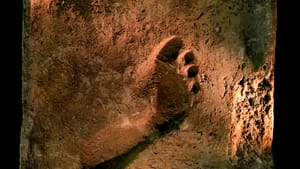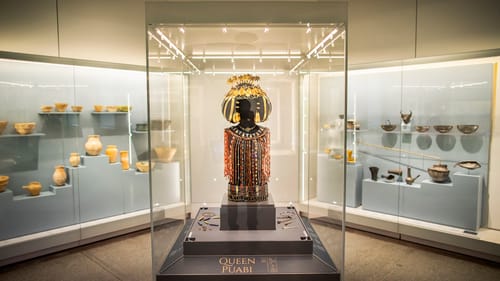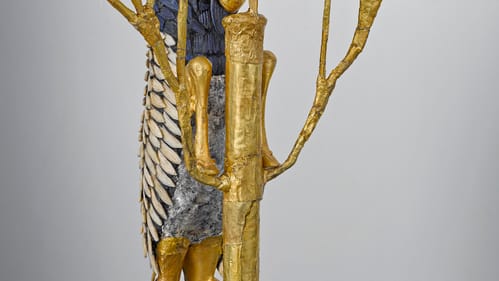Stay in the Loop
BSR publishes on a weekly schedule, with an email newsletter every Wednesday and Thursday morning. There’s no paywall, and subscribing is always free.
A grand illumination
Middle East Galleries open at the Penn Museum

The light is the first thing you notice. It’s pleasingly bright in the Middle East galleries, the first completed portion of the Penn Museum’s massive renovation. The new galleries are illuminating in more ways than one, though.
Covering 6,000 square feet just off the main entrance, the galleries hold signature pieces that draw visitors from around the world. Given that the Middle East collection represents glowing archaeological achievements, it’s incredible there have never before been permanent galleries dedicated to these materials.
Many of the artifacts were gathered in expeditions and excavations at the museum’s genesis, such as Nippur, Iraq, in 1889 and Ur (Tell al-Muqayyar), Iraq, where Penn worked with the British Museum beginning in 1922.
Until now, a rich cache from Mesopotamia and Persia, today Iraq and Iran, has only been glimpsed as part of focused exhibitions. While several starring items have rarely been out of view, such as "Ram in the Thicket" (Ur, Iraq, c. 2450 BCE), others have never been seen in the museum. The new installation puts more than 1,200 artifacts on view together in a brand-new setting.
Artifacts illustrate how they lived
According to Lynn Grant, Penn Museum’s head conservator, 1,600 items were prepared for possible exhibition and narrowed down as themes were refined. The presentation sweeps visitors through the story of civilization, from the establishment of cities, empires, and trade relationships to the development of art, literature, and belief systems.
Overarching themes are made tangible through individual artifacts and stories. Items range from Queen Puabi of Ur's funerary regalia to a simple bowl bearing the impression of the fingers that shaped it, pressing damp clay into a mold. That bowl and several other items have been faithfully reproduced for visitors to handle.
Objects are grouped to illustrate ideas. For example, a collection of cylindrical stamps made of clay and shell are displayed with samples of the decorative impressions they produce when rolled across a pliable surface. Mesopotamians offered the stamps to gods they believed were patrons and protectors.
Human origins, genesis of a museum
The new galleries not only shed light on civilization’s origins, they illustrate the museum’s beginning when American archaeologists were anxious to join the British and French in exploring the Middle East. Within a year of its 1887 founding, Penn Museum conducted expeditions and excavations. Its commitment to the region has continued and evolved into partnerships with native organizations to study and preserve local cultures.

Ninety-five percent of the items on view were excavated or collected directly by Penn, so their exact locations are known. According to Naomi Miller, one of 10 Penn curators on a team that worked with exhibit designers from Haley Sharpe Design, that detail led the team to designate place, rather than time, as the organizing principle.
Showing where items were found and how people used them adds meaning for non-archaeologists, who don’t necessarily think in epochs. These and other techniques enhance the presentation relating to Mesopotamian city Ur, the subject of a joint exploration by Penn and the British Museum that began in 1926.
You are there
An imaginative sketch animation, Journey Through the City of Ur, runs at the center of the display. It allows viewers to slip into the sandals of an ancient Mesopotamian walking through narrow streets toward the ziggurat, a pyramid-shaped structure. They move through market crowds, pass donkey carts, goats and pigs, and eventually board a reed boat for a sail. Silent and without captions, it gives viewers a few moments to feel, rather than think about, the place.
The short animation exemplifies what Dan Rahimi, executive director of galleries and point person for the project, believes is the installation’s greatest accomplishment: providing context.
“Where we were sure [of details], we illustrated carefully,” Rahimi explains. So elements of Ur for which archaeological evidence exists are fully rendered, while more speculative parts of the scene are drawn with simple lines.

“We knew what the carts looked like, we knew what the bricks looked like, we knew there were pigs,” Rahimi says. “We had the image of a musician and knew the way reed boats looked. We knew the weave of the baskets from impressions that were found.”
Touchscreens throughout the galleries invite visitors to scroll, swipe, and tap for more information. Set low enough for children or those in wheelchairs to reach, the screens are among many features that make the galleries welcoming to visitors of varied ages, interests, and physical capabilities.
Guides share firsthand experience
Programming is also aimed at multiple audiences. Most prominently, the Global Guides program, staffed by recent settlers from Iraq and Syria, provides firsthand perspective to visitors.
Four participants were recruited and trained to interpret and lead tours, and additional guides from African, Mexican, and Central American backgrounds will join when those galleries open next year. Steve Tinney, coordinating curator of the galleries, believes the Global Guides program is the first of its kind in the country.
Ali Arif moved to Philadelphia with his family from Iraq, where he worked as a translator for the U.S. military. He's eager to talk to visitors and quick to point out, “People are similar, different cultures, different traditions, but the same.” Without dismissing the violence that dominates news of Iraq, Arif says the picture is incomplete: “There are bad things, but it’s also like here — regular people, living their lives.”
That’s the overarching message of the new installation: This story belongs not just to the Middle East, but to the world. It’s the story of civilization, people living their lives — people with whom we have a lot in common.
What, When, Where
Middle East Galleries Opening Weekend Festival. April 21-22, 2018, at the Penn Museum, 3260 South Street, Philadelphia. (215) 898-4000 or penn.museum.
Sign up for our newsletter
All of the week's new articles, all in one place. Sign up for the free weekly BSR newsletters, and don't miss a conversation.
